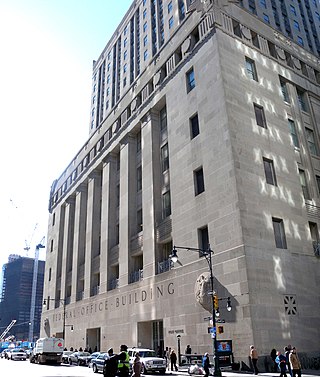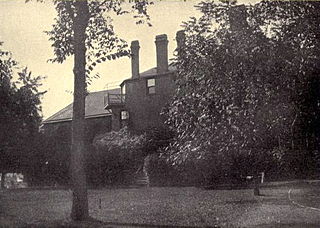
The Wayside, also known as the Henry Demarest Lloyd House, is a historic house at 830 Sheridan Road in Winnetka, Illinois, United States. An extensively altered mid-19th century country inn, it was from 1880 until his death in 1903 the principal residence of Henry Demarest Lloyd (1847–1903). Lloyd was a leading "muckraking" journalist of the late 19th century, and a major editorial voice against corporate monopolies and for organized labor. His house was declared a National Historic Landmark in 1966.

The Wayside Inn Historic District is a historic district on Old Boston Post Road in Sudbury, Massachusetts. The district contains the Wayside Inn, a historic landmark that is one of the oldest inns in the country, operating as Howe's Tavern in 1716. The district features Greek Revival and American colonial architecture. The area was added to the National Register of Historic Places in 1973.

Villa Maria Motherhouse Complex, or Felician Sisters Immaculate Heart of Mary Convent Chapel and Convent, is a historic Roman Catholic convent located at Cheektowaga in Erie County, New York. It is included in the Roman Catholic Diocese of Buffalo. It was constructed in 1927, and is a three-part Gothic Revival building that was built for the Felician Sisters of St. Francis to house a boarding and day high school, public and private chapels and the Motherhouse/Novitiate. The school, known as Villa Maria Academy, closed in 2006. The school property was repurposed as affordable housing for seniors.
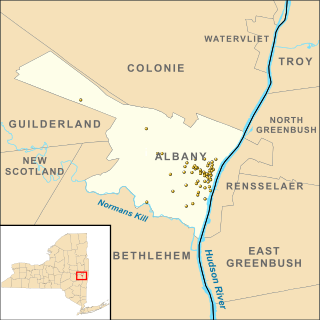
There are 75 properties listed on the National Register of Historic Places in Albany, New York, United States. Six are additionally designated as National Historic Landmarks (NHLs), the most of any city in the state after New York City. Another 14 are historic districts, for which 20 of the listings are also contributing properties. Two properties, both buildings, that had been listed in the past but have since been demolished have been delisted; one building that is also no longer extant remains listed.

First Universalist Church of Portageville, also known as The Portageville Chapel, is a historic Universalist church in Portageville, Wyoming County, New York. It is a Greek Revival style structure with Gothic and Federal elements dating to 1841. The church features a two-stage square tower above the north gable of the building.

Saint Bernard's Seminary is a historic former Catholic seminary complex located at Rochester in Monroe County, New York. The educational institution formerly inhabiting the complex changed its name to St. Bernard's Institute and moved to the campus of Colgate Rochester Divinity School in 1981 and was renamed again to St. Bernard's School of Theology and Ministry when it moved to a new campus on French Road in 2003. The original property was owned by Kodak between 1982 and 1992. It was eventually sold to a private developer and is now a senior citizen residential complex.

The Church of the Immaculate Conception and Clergy House at 406–412 East 14th Street between First Avenue and Avenue A in the East Village neighborhood of Manhattan, New York City were built in 1894–1896 by Grace Church, one of the most prominent Episcopal churches in the city at the time. The buildings were a free chapel – meaning there was no pew rent – called Grace Chapel and a connected Grace Hospital, which could serve 16 senior citizens and 10 children, and was physically connected to the chapel by a bridge, so that patients could be wheeled to services.

Mead Memorial Chapel is a historic Episcopal chapel at 2 Chapel Road in the hamlet of Waccabuc, town of Lewisboro, Westchester County, New York. It was designed by Hobart B. Upjohn (1876-1949) and built in 1905–1906 in a late Gothic Revival style. It is a rectangular stone building with a steep slate roof. A wing was added in 1929, known as Mead Memorial Hall, and it houses the Mead family archives. It features a bell tower pierced by Gothic arch shaped louvered windows. It was built by Sarah Frances Studwell Mead as a memorial to her husband, George Washington Mead (1827-1899). The Mead family also owned the separately listed The Homestead.
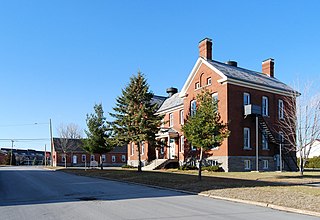
United States Oval Historic District is a national historic district located on Plattsburgh Air Force Base at Plattsburgh in Clinton County, New York. The district includes 26 contributing buildings and one contributing structure. The district consists of post headquarters, barracks, officers' quarters, a hospital, a chapel, and various buildings surrounding a broad parade ground. All were built between 1893 and 1934 by the U.S. Army as components of the former Plattsburgh Barracks.

The New York County Lawyers' Association Building is a structure at 14 Vesey Street between Broadway and Church Street in the Financial District of Manhattan, New York City. It was built in 1929–30 and was designed by architect Cass Gilbert in the English Georgian style for the Association, which was founded in 1908. Gilbert's design complements Trinity Church's St. Paul's Chapel, which sits across the street.

Sea Cliff Village Hall, Library and Museum Complex is a historic civic building complex located at Sea Cliff in Nassau County, New York. The complex is a grouping of three functional units in two interconnected buildings originally built in 1914 as the Sea Cliff Methodist Church, Sunday School / Chapel, and Rectory. It is constructed of beige brick with cast stone accents and slate-covered roofs in the Late Gothic Revival or Collegiate Gothic style. It features a square bell tower. The former rectory contains the museum and is a two-story rectangular building in the Tudor Revival style.
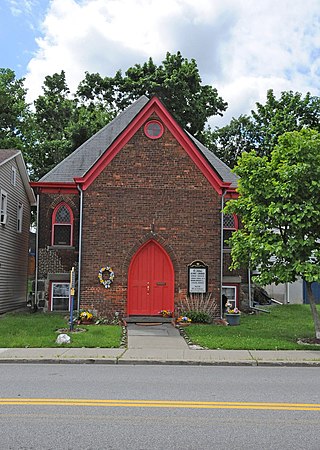
Olivet Chapel, since 1965 known as the A.U.M.P. affiliated St. John's African Union Methodist Protestant Church, is a historic Presbyterian African American mission chapel located in Goshen in Orange County, New York. It was built about 1910 and is a load-bearing masonry building with a bluestone foundation and topped by a high hipped roof. Horace Pippin (1888–1946) was a noted member of the church prior to its moving to Olivet Chapel.

Seaview Hospital is a historic hospital complex in Willowbrook on Staten Island, New York. The original complex was planned and built between 1905 and 1938 and was the largest and most costly municipal facility for the treatment of tuberculosis of its date in the United States. After being shuttered, the complex was listed as a national historic district.

Wayside Cottage is a historic home located at Scarsdale, Westchester County, New York. The earliest part of the house was built about 1720 and is the four-bay-wide, two-bay-deep, 1+1⁄2-story south section. It sits on a fieldstone foundation and has a gable roof and verandah with Doric order piers. The center section of the house was built in 1828 and it is a 2+1⁄2-story, three-bay-wide structure with a gable roof and sheathed in clapboard. A third section is known as the "caretaker's quarters" and was built in the late 19th century. It is two stories high, three bays wide, and two bays deep. A wing was added to this section in 1928. The house underwent a major restoration in 1953–1954. Since 1919, it has been owned by the Junior League of Central Westchester. It was also where Scarsdale Public Library used to be.

The Kolping Park and Chapel is a religious facility previously located at 47440 Sugarbush Road in Chesterfield Township, Michigan. It was listed on the National Register of Historic Places and designated a Michigan State Historic Site in 1996. On September, 28th 2016 the chapel was moved to the Chesterfield Historical Village at 47275 Sugarbush Road.
The St. Joseph's Chapel in Minto, North Dakota, United States, includes Stick/Eastlake, Colonial Revival, and Late Gothic Revival architecture. It was built in 1907. It was listed on the National Register of Historic Places in 1994.

Sam Brown Memorial State Wayside is a historical park in Browns Valley, Minnesota, United States, established in 1929 to honor frontiersman Sam Brown (1845–1925). On April 19, 1866, Brown rode 55 miles (89 km) to warn other settlers of an impending attack by Native Americans, and when the threat proved false he rode back through a spring blizzard to intercept his dispatch to the U.S. Army, suffering injuries that left him in a wheelchair for the rest of his life.

The Taylor–Van Note House, also known as Blairs Ferry Wayside Inn/Vanesther Place, is a historic building located in Cedar Rapids, Iowa, United States. Charles Taylor had this two-story, wood frame, vernacular Greek Revival house built in 1846. The family owned the house until 1888 when it was sold to Lazarus Van Note, whose family owned it as late as 1985. Oral legend has it that Taylor rented the front rooms to travelers as they passed through the region. It was located close to James Blair's ferry across the Cedar River, which is why it has long been known as the Blairs Ferry Wayside Inn. The house was built of heavy timbers and exemplifies a traditional I-house. It features two rooms on both floors across its length, and one room deep. The main door is flanked by sidelights and a transom across the top. The house was listed on the National Register of Historic Places in 1985.





